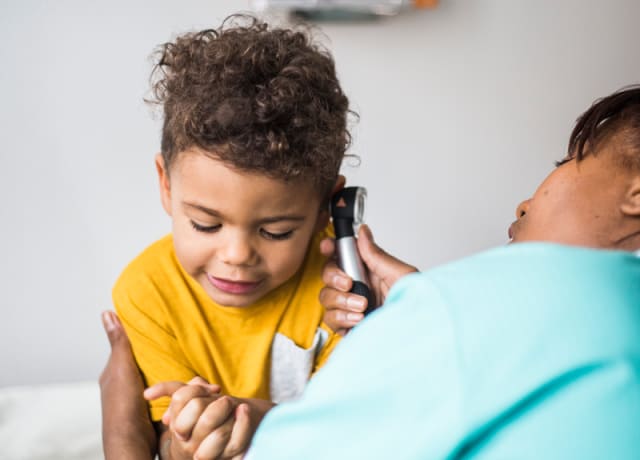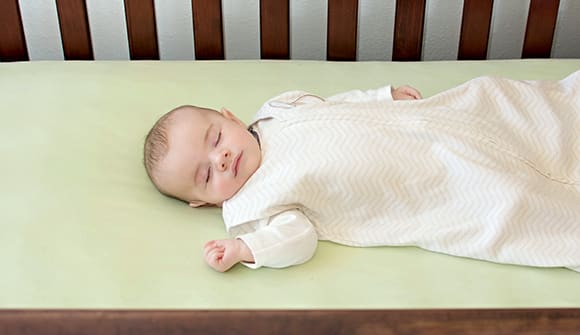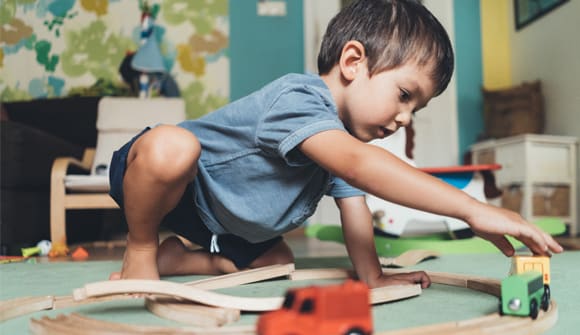ENT talks ear tubes
Everything parents should know about this common childhood procedure.
Article Author: Katie McPherson
Article Date:

Each year, more than one million sets of ear tubes are placed in the United States. It’s the most common pediatric ENT procedure performed, and you likely know someone whose child has had it. If your little one is scheduled for the procedure to help alleviate ear infections, it’s normal to feel nervous or unsure about what to expect.
Ear tubes are used to treat recurrent otitis media (ear infection), sometimes with effusion, which is trapped fluid in the middle ear that can muffle hearing. Tubes allow the middle ear to drain, decreasing the number of potential ear infections. Once a child has tubes, the occasional ear infection that may occur can be treated with prescription ear drops instead of oral antibiotics.
Gary Josephson, MD, a community pediatric otolaryngologist (ENT), answered questions about ear tube placement and shared a general rundown of what happens when you and your child arrive for surgery.
How long do ear tubes last, and what happens to them after that?
“Traditional tubes last about a year, sometimes a little longer. Occasionally, they come out sooner. When the tubes fall out, they usually do so by themselves and the eardrum repairs itself. Less than 1% of the time, it will leave a little hole in the eardrum, which would require another procedure down the road to repair.
“Some children don’t lose either of their tubes. If they’re in for more than two years, the surgeon may consider removing them, which is a very short procedure, as well.”
What does ear tube placement entail?
“During the procedure, a small incision is made in the eardrum and the tube is inserted. This allows the middle ear to drain, preventing fluid accumulation. If an infection occurs, the drainage prevents ear pain and fever. This also allows the infection to be treated with topical antibiotic drops.”
How long does the procedure normally take?
“Five to 10 minutes. The placement of tubes is done under gas mask anesthesia, so there’s no IV or breathing tube involved. The child is usually awake and ready to go home 30 minutes to an hour later.”
What can parents expect on the day of surgery?
“Generally speaking, the parent and child will arrive and get checked in by nursing staff, then meet their surgeon and anesthesiologist. Then the child will be brought back to the operating room, where gas mask anesthesia is administered and the child goes to sleep very quickly.
"After the procedure, the mask is removed, the child wakes up and is brought back to be with their parents. They will be observed for about 30 minutes and can then be discharged."
What is the recovery like?
“If the child has fluid in the ear or an ear infection at the time of tube placement, the doctor may send him or her home with ear drops. Other than that, there’s no aftercare necessary. We’ll schedule a follow-up appointment to see the child six weeks after surgery to make sure everything is going well, and if they had hearing loss, that their hearing is restored. Going forward, we like to see them once every six months just to check on the tubes.
“Many parents also wonder if their child will need to wear earplugs in water once they have tubes. New guidelines suggest you don’t have to for bathing or swimming in a pool. In a lake or ocean, we might still recommend it since it’s not filtered or ‘clean’ water.”
How can parents help their child prepare for the procedure?
“Once your child has met the doctor during his or her initial visit, the parent should share with the child that tube placement is going to occur. Explain that you’ll see the doctor again on the day of. Wolfson Children’s Hospital has child life specialists to help children prepare for procedures, and usually, one will be there to help make the transition easier for the child going into the operating room. There are also children's books about surgical procedures you can use to help prepare your child.”
If you think your child would benefit from ear tubes or you have questions about ear, nose and throat conditions, click here to learn more.



